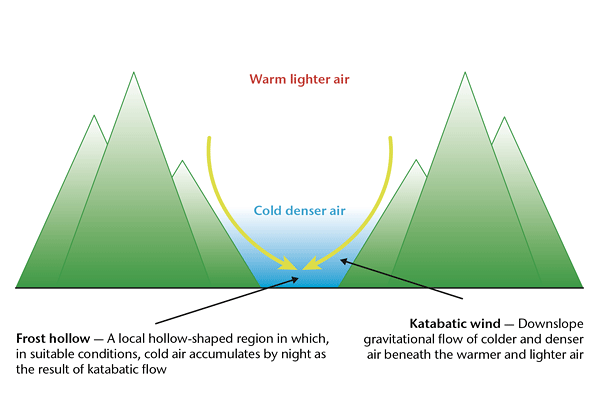Anabatic = moving upwards ; Katabatic = moving downwards .
Anabatic winds which flow upslope of a mountain from lower valleys develop during daytime in calm sunny weather. They are warm winds which blows up a steep slope or mountain side, driven by heating of the slope through insolation. Air which is in contact with slopes
that are warmed expands upward and cool and sinks
over neighbouring valleys.
Anabatic
winds are usually slow, at only 1-2m/s and are rarely
important expect near coasts where they can increase
the strength of sea breezes. Anabatic winds are particularly useful to soaring glider pilots who can use them to increase the aircraft's altitude. Anabatic winds can be detrimental to the maximum downhill speed of cyclists.
Katabatic winds are downslope winds flowing from high elevations of mountains, plateaus, and hills down their slopes to the valleys or plains below.During and after sunset, particularly on a clear day/night, air at and near the top of elevated land surfaces, particularly over snow-covered surfaces, cools relatively quicker than air at lower altitudes. As air cools it becomes denser and therefore heavier. The cold air then flows down the side of the mountain, resulting in a katabatic flow (or wind). Since the katabatic winds are descending, they tend to have a low relative humidity, which desiccates the region. This may also create an adverse effect during forest wildfires in which katabatic winds may fan the flame with more serious consequences. eg.➤ Santa Ana wind (California).
The cold katabatic wind that gets accumalated at the valley bottom leads to a phenomenon called 'Temperature Inversion', in which the temperature, instead of falling, increases with height above the ground. Theses temperature inversions are also caused by anti-cyclones. In inversion layers, both vertical and horizontal diffusion is inhibited and pollutants become trapped. Hence, pollution events are more likely to occur under temperature inversion conditions.
Bora is a katabatic wind flowing from the Balkan Plateau down to the Adriatic, resulting in cold and strong winds.


Comments
Post a Comment